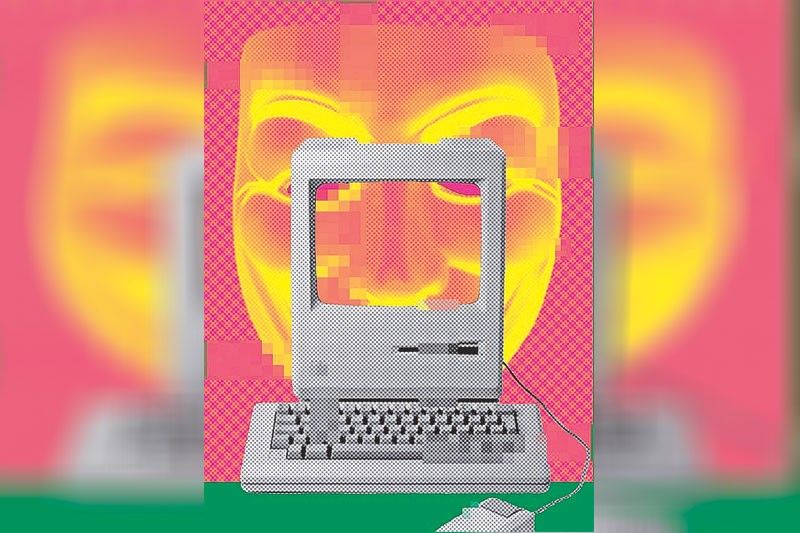What's in a mask?

I feel like I’m dusting off a magical artifact. The power of this thing is the stuff of Indiana Jones relics, like it was wielded in a bygone era as a threat to kings, because it was.
In 2008, internet-based hacktivist group Anonymous organized Project Chanology, a series of protests targeting the Church of Scientology. In response to the church attempting to censor a video of Tom Cruise extolling the virtues of scientology — back when we weren’t super sure if the actor was actually a brainwashed cult pawn — members of the faceless collective went out donning the Guy Fawkes mask. The V for Vendetta movie came out three years prior. Since then the visage of V served to function as the de facto symbol of Anonymous, and an up-for-grabs costume for just about any movement that wanted to stick it to The Man.
From 2008 to a sizable portion of the 2010s, we accepted the Guy Fawkes mask as a universal symbol of resistance. Never mind the complications of appropriating the likeness of someone who fought for Catholic Spain and masterminded a plot that ultimately failed. The mask was menacing, and there was a thrill to watching a movie character seemingly step out of the silver screen, take the form of legion, and f**k sh*t up. We saw that mustachioed mask, smirking with all the confidence of a gunpowder enthusiast, make memorable cameos in the most important demonstrations of our time, from the Occupy Movement to Arab Spring.
And does anyone else remember that one time when Anonymous hacked into Philippine government websites to play Wake Up by Rage Against the Machine? Absolutely mental. We watched a single image mutate to serve different purposes and send riling messages. The Guy Fawkes masks literally taught us how memes worked.
I never owned a mask, though. Let’s be honest with ourselves: it got corny. Who else hasn’t felt their eyes roll out of their sockets every Nov. 5, as scores of basics on your feed pleaded you to remember, remember what date it is? (Guy Fawkes Day, duh.) What was once a lively symbol of resistance that could animate our capacity for struggle has, over the years, become a tame and defanged caricature. In an ecosystem of signifiers, the mask is now just another passé Halloween costume, misappropriated by the same specimen of frat boy that watched Fight Club without catching the anti-establishment messaging therein. The Guy Fawkes mask is our generation’s Che Guevara T-shirt.
Oh, but I took it for granted, if I’m being honest. I took for granted the image of a crowd mobilizing as one avatar, a common face that must have resonated with Emmanuel Lacaba’s idea of facelessness.
I’ve been seeing less of it. It seems that after the election of both Duterte and Trump, the face of V became an endangered species of symbol, popping up at odd times and in random spots, the sight of it comical. (The visage of Joaquin Phoenix’s Joker has shown up in protests in Chile and Hong Kong, which was interesting to see, to say the least.) It’s an ugly thought to consider, that a symbol of struggle could fall out of fashion, as if the flames of revolution could only be stoked by blockbusters. Does that really work? Where are all the art therapy gigs you all joked about taking on after Parasite swept the Oscars?
So. As though chafing under the mask, feeling more suffocated than free, agents of change marched into the fray showing their faces. Consider the #MeToo movement, the Black Lives Matter movement, and the LGBTQ+ rights movement, which all involve human beings bravely sharing their stories of abuse under a cispatriarchal, white supremacist system, at the risk of jeopardizing their lives and social status. Why the need for an eye-catching emblem when real stories are powerful enough, when it is already impossible for us to look away? No need for symbols. No hiding behind Guy Fawkes. It seems that now, those who struggle are saying to those in my power: look at my face, look at my pained expression, look right in the eye of the people you’ve oppressed. That spirit still applies even when we’re all marching with N95s on.
One could make the argument that Guy Fawkes masks are due for a comeback, what with the looming, growing threat of state surveillance and suppression, and us scrambling for new ways to bolster our digital privacy. Anonymous recently made a hell of a comeback after the murder of George Floyd by hacking the Minneapolis Police Department website, accusing Donald Trump of being Jeffrey Epstein’s killer, and implicating celebrities like Will Smith, Alec Baldwin and Chris Evans (no!!!) in a child trafficking ring. This dark timeline refuses to pick a lane.
Maybe the mask of V can return to the fold struggle as a trusted image of revolt, but why should we limit ourselves to one symbol, worn-down and overused, or even turn to symbols at all? Visuals of that vogue vaudevillian vigilante used to invigorate, evidenced by the vagabonds in vantablack vestments that vaunted V’s visage and vociferated, movement after virtuous movement, in the vein of valor. Now only vestiges of V’s veneer remain. As visions of violence grow more vivid, vis-à-vis viral videos, so too must we vie for versatility. We must venture into new avenues and vehicles for voicing our verdicts, vindicating victims, and voting villains out of government. The verdict? Maybe it’s time for some variety.















